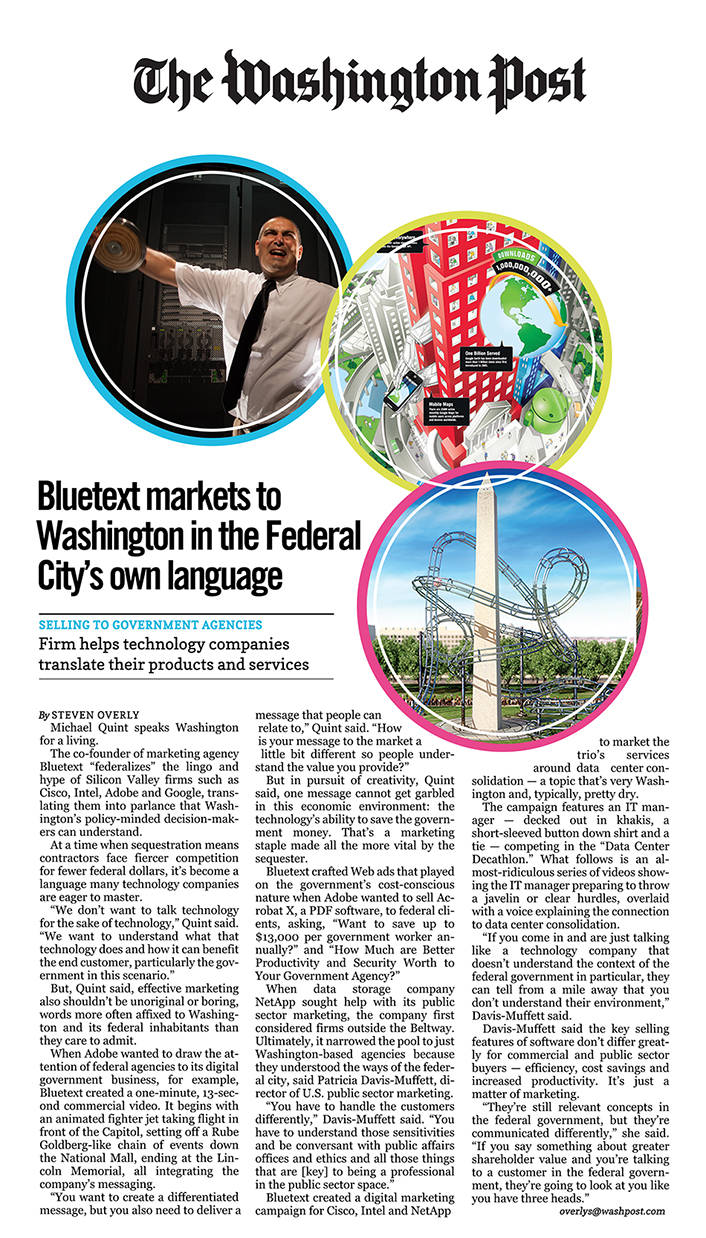
 The third-party cookie is under attack and may soon be a thing of the past. Microsoft recently confirmed that it was developing a new tracking technology to eclipse the cookie. The idea is to have a proprietary product that it controls across platforms allowing it, and other large players, to consolidate their power through newer tracking technologies.
The third-party cookie is under attack and may soon be a thing of the past. Microsoft recently confirmed that it was developing a new tracking technology to eclipse the cookie. The idea is to have a proprietary product that it controls across platforms allowing it, and other large players, to consolidate their power through newer tracking technologies.
That might sound like the natural progression of online marketing. After all, cookies have several challenges that critics use to argue for their demise. From a privacy stand-point, many privacy advocates see third-party cookies, the ones that marketers and advertisers use to follow individuals, as intrusive. And indeed, Microsoft and other players say they have protecting consumer privacy in mind with their new technology.
But more important from a marketing standpoint, cookies are remnants of technology designed to follow users across desktop browsers. They don’t transfer to mobile devices and platforms, let alone Xbox, PlayStations and connected television and the host of new ways consumers are accessing the Internet. An advertiser has no way of knowing, for example, if a sale came from an ad viewed on a cell phone or other device because of this limitation.
On the other side of the debate, advocates for cookies point out their benefits, including as an open source technology that has been a key element in “democratizing” the Web. The technology has allowed small publishers and bloggers to flourish, and has enabled marketers to anonymously and efficiently target consumers on the Internet.
Let me give you an example of how we use cookies for our clients’ campaigns to deliver the right kind of information to their potential customers. As part of a campaign, we often create lead-generating landing pages and microsites that contain useful information on an industry challenge for which a company has a range of solutions. A visitor might go to that site and search for white papers or other premium content on a specific challenge they are facing. By utilizing an anonymous cookie to that individual, we can serve up a series of banner ads that direct him or her to more information. If the person had gone to a page on pricing, a marketer can logically guess that this person is most likely a potential buyer and can deliver banners that are tailored to that stage of the buying process. Cookies enable this type of efficient and effective targeting to work.
As one observer recently wrote, “In clamoring for the demise of third-party cookies, privacy advocates may be urging the creation of a system that elevates proprietary tracking technology – technologies that may stifle competition and may be an even bigger privacy concern with personal data being concentrated in the hands of a few powerful corporations.”
We’re not quite that alarmist, but it is worth recognizing that third-party cookies are an important part of many of the targeted campaigns that Bluetext designs and implements for its clients. They allow companies to identify potential customers who have expressed an interest in their solutions through Web searches, and provide information and links tailored to those specific interests. This type of narrow-casting ad delivery makes targeting much more efficient, serves up information relevant rather than random to users, and provides needed revenue streams to web properties including news and information sites.
“In order to pay for a better and more expensive internet we need to continue to improve online advertising,” said Zach Coelius, CEO of automated ad buying company Triggit told AdAge. “There are only two ways we can do that: One is to make the ads more intrusive, bigger and in your face, or two, we can make them more targeted so that we no longer have so much waste with the wrong ads going to the wrong people.”
Why is this so important for marketers? First and foremost, it marks a potential trend by Microsoft and other large internet platform companies to control how individuals are tracked and followed across their browsing. That’s good for those large corporations, but not so beneficial for companies that will have to purchase or obtain that information from them. It reverses the path of “democratizing” the Internet that cookies allowed for in the first place.
So what do marketers need to do now that Microsoft is going to make it more difficult to identify and track potential customers through third-party cookies? Here are a few recommendations:
- First, cookies aren’t going away yet. There will still be a need and market for them, so don’t abandon the ship.
- Be creative! Targeted campaigns that use premium content and compelling creative will attract attention from potential buyers and customers.
- Content will still be king, and content syndication can drive key targets back to your campaign site.
- Three-part campaigns that combine digital, physical and follow-up marketing will deliver better results than a one-dimensional effort.
- Follow the trends. If the large platform players are transparent about the information they collect on your behalf and can demonstrate solid results, they may be worth a try.
- Social media sites that allow segmented targeting, like Facebook and LinkedIn, will offer strong alternatives to traditional banner ads.
- Try a little bit of everything, split test messages and creative, and refine and revise until you have the best combination to deliver the results you want.
Georgia-Pacific turned to Bluetext to develop a campaign to most effectively share its approach for sustainable forestry in the United States. In the United States, the free market economy, private property ownership and a strong rule of law have created an environment where forests are responsibly and sustainably managed, and illegal logging is not an issue. Georgia-Pacific practices, promotes and supports sustainable forestry through a broad range of methods which are outlined in this infographic themed “Seeing the forest for the trees.”
On November 7th, the IRS Design Office hosted the second Design in Government (DIG) meeting in the main IRS Auditorium, the only meeting gathering of federal graphic designers government-wide. The goal of the DIG meeting was to strengthen the federal graphic design community and to help build relationships across federal agencies to encourage networking and discuss innovation, design management and design complex issues in a collaborative way, during these difficult budget times. Partner Jason Siegel presented the following presentation with supporting videos.

Everywhere you turn, people are talking about responsive design. It is a critical website solution for providing your customers and prospects a seamless experience across all devices and making it easy for you to manage one web infrastructure.
With a responsive website, businesses can be in front of consumers at every step of their online journey. A user viewing a website on the go via a mobile device can have the same powerful experience as when sitting in their office.
Responsive websites provide continuity between different viewing contexts, remaining completely agnostic to the type of device used and the size of the screen it has.
Unfortunately, a mobile version of your website isn’t good enough anymore. Responsive websites simplify internet marketing and SEO. Instead of having to develop and manage content for multiple websites, businesses with responsive sites can take a unified approach to content management because they have only the one responsive site to manage. The same applies to analytics and strategy development and deployment. A responsive website means there is only one set of analytics to examine and a single strategy to develop and deploy.
Responsive websites are easier for consumers to find than traditional or mobile sites because they come up higher in search engines’ rankings. Google recommends responsive web design because having a single URL for desktop and mobile sites makes it easier for Google to discover content and for Google’s algorithms, which are constantly changing, to assign indexing properties to content.
Responsive Design in the Future
Responsive design is still in its infancy, and the future looks extremely bright. All of our websites are responsive today, and our developers are exploring emerging areas of responsive design by testing a multitude of integrations that are now available.
As the internet transforms further into a platform of services and user interfaces that tie those services together, leveraging responsive design principals will allow companies to integrate a plethora of back-end services, such as Facebook, Twitter, Salesforce.com and Amazon Web Services, and then present the integrated data to users in an integrated manner. Expensive back-end solutions are no longer a requirement to integrate legacy systems with business partners.
One thing is certain, you don’t want to fall behind and watch your competitors launch responsive websites while yours is still stuck in 2012. The time to get responsive with your web design is now.
WASHINGTON – October 7, 2013 – Bluetext, one of the nation’s fastest growing digital marketing, branding, and strategic communications firms, today announced that Partner and Co-Founder Jason Siegel has been named a winner of the Direct Marketing Association’s “40-Under-40” award for 2013. The award recognizes marketing luminaries who have already left an indelible mark within their organizations and on the industry as a whole.
DMA noted in its announcement of the honorees that these leaders in the marketing industry have “launched initiatives that have helped to significantly grow their companies; wowed clients with creative or strategic plans that have made a major impact on those clients’ businesses; and influenced the industry in numerous ways—from enhancing the core elements of direct marketing, to advancing measurement, to guiding their company and clients on mastering new technologies, and much more.”
“This is an important award both for me personally and for Bluetext, because it validates the value of firms like ours that are solely focused on senior-level involvement to help solve our clients’ most difficult challenges in their transition to digital strategies,” said Jason. “DMA is at the forefront of these changes, so to be recognized by the Association is a huge honor.”
DMA stated that the award winners’ efforts are “helping to guide others in marketing to master such areas as integrating digital and traditional marketing, using cross-channel data to inform marketing decisions, and building loyalty at a time when customers churn at the click of a mouse. Their stories are ones of determination, creativity, and adaptability.”
Jason and the other winners were honored at a ceremony in New York that featured Ikea CMO Leontyne Green Sykes.
Looking for a DC WordPress development company? You have found the right WordPress development company! We are located in Georgetown Washington, DC. The WordPress developers at Bluetext are fun, energetic, and dedicated to the cause. There is a level of professionalism that comes with hiring us that you won’t get with any other Washington DC web development company. We love discovering new tools to help create the best sites for our clients. WordPress is currently one of the most popular CMS’s to have a site built on, and we understand why. In fact, we think so highly of WordPress that we have built our own website on it! It is a great resource for companies of all sizes. If you work with us keep in mind, throughout the development process we will offer WordPress training so you will be able to make any and all edits and you decide are necessary.
Our DC WordPress developers will work with you to build a new web presence that you can be proud of. We choose to work with WordPress because it allows our developers to have complete control over the layout of the site yet it is still easy for site administrators to make any and all edits to the page. Our Washington DC WordPress development company has built a reputation of excellence. Get in touch with us today to learn how we can help you improve your web presence. Throughout the entire process, we will work closely with you to build a top of the line, modern looking site that engages your audience and decreases bounce rates.
BENEFITS OF A SITE BUILT ON WORDPRESS
- We can help you improve your online presence with a custom built WordPress site through:
- Custom WordPress Plugins
- WordPress Training
- Extensive knowledge of WordPress themes
- Custom website development
- WordPress hosting advice
- Experienced WordPress team
- Top of the line features
- A passion for development
APRIL 22 – WASHINGTON – Bluetext, one of the fastest growing digital marketing, branding and communications agencies in the country, and GreenTrees, the largest carbon reforestation company in North America, today launched a comprehensive corporate sustainability platform designed to enable enterprises to demonstrate and quantify environmental, financial and social benefit. Companies such as Duke Energy and Norfolk Southern Railways are experiencing the benefits of the GreenTrees program.
The GreenTrees program offers companies a way to invest in proven reforestation efforts that provide carbon offsets, water credits, biodiversity and other environmental benefits. Bluetext provides a turnkey communications platform that lets customers, partners, and investors know about a company’s participation and investment in GreenTrees reforestation.
“Large corporations often have difficulty demonstrating their commitment as environmental stewards and to sustainability,” said Chandler Van Voorhis, Managing Partner of C2I, the driving force behind the GreenTrees program. “The GreenTrees reforestation program offers a short path to environmental leadership and CSR goals. Partnering with an innovative company like Bluetext will help companies communicate effectively about the benefits of their participation in this program.”
GreenTrees grows world-class, healthy forests to heal a vital part of our country. The outcome produced is an ACRE (Advanced Carbon Restored Ecosystem). The monetization of this restoration is a conduit to connect private capital to private landowners for the public good.
This joint program includes both the development of the GreenTrees proven CSR program wrapped around an integrated CSR campaign development and implementation strategy.
“When the opportunity to launch something unique with GreenTrees arose, it perfectly aligned with our core principles of being a good company that helps our clients become good corporate citizens,” said Jason Siegel, partner at Bluetext. “Our team has worked on many exciting corporate social responsibility programs for global enterprises and we are confident that as more companies learn about the benefits of GreenTrees and our platform for getting their message out they will recognize the value of this innovative program.”
About Bluetext
Bluetext delivers comprehensive digital marketing, branding, and strategic communications services to our clients, who range from global leaders in their industries to emerging companies at the forefront of innovation and technology. Organizations turn to Bluetext because of our reputation for developing robust and highly scalable digital platforms designed to optimize brand performance in an increasingly digital environment. Our team has delivered some of the most creative and effective campaigns for organizations looking to increase their presence and brand in this market. We have successfully positioned lesser-known organizations as thought leaders, and taken better-known organizations to a new level, differentiating and delivering a brand promise that resonates with the market. There is no one-size-fits-all approach. Our goal is to get a seat at the table with you, understand your goals, audit what you have done and what resonates with your audience, and deliver an integrated strategy that will give you a long-term platform for success. To learn more visit www.bluetext.com
About GreenTrees
GreenTrees delivers the Currency of Conservation. GreenTrees starts from a tree planting approach, grows the forest to produce carbon, and then lets the carbon become the base for a series of forest assets – biodiversity, air, and water – we call it ACRE (Advanced Carbon Restored Ecosystem). Forests are nature’s cathedrals, and we cement a legacy and turn out sustainability credits for investors seeking the best in credentials for their work. To date, GreenTrees has over 2 million tons of carbon credits under contract for Fortune 500 companies, making GreenTrees the leading reforestation carbon company in North America. To learn more visit www.green-trees or http://vimeopro.com/greentrees/planting
Read the story at WashingtonPost.com here.

